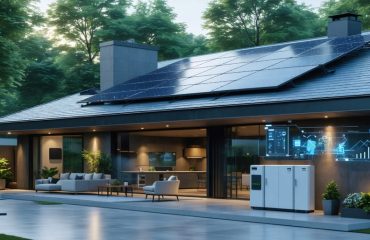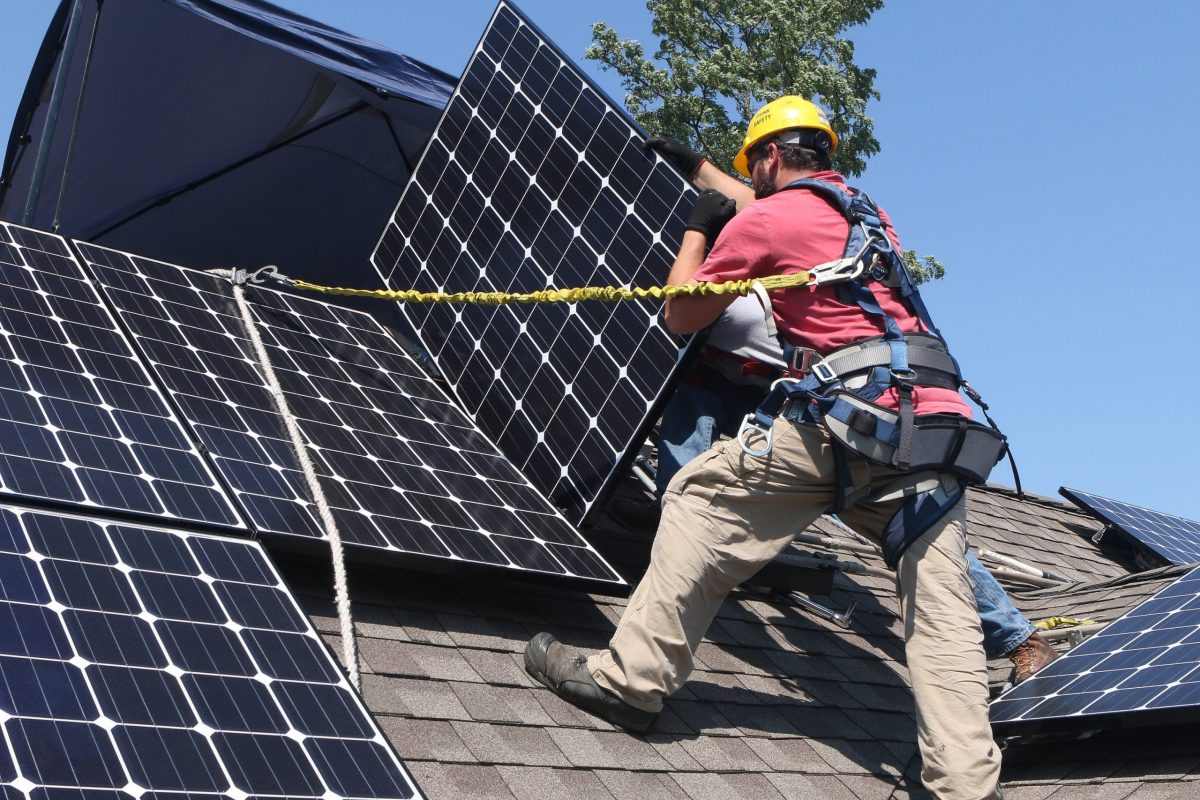Imagine capturing solar energy during the day, converting it into hydrogen fuel, and powering your home for days without drawing from the grid. Solar power hybrid systems represent the next frontier beyond traditional battery storage, combining photovoltaic panels with hydrogen production and fuel cell technology to create truly independent home energy systems.
Unlike conventional solar setups that store electricity in lithium batteries for 12-24 hours, these innovative systems convert excess solar power into hydrogen gas through electrolysis. This hydrogen acts as a long-term energy reserve that can be converted back to electricity when needed, potentially providing weeks of backup power instead of hours. Think of it as transforming your home into a miniature clean energy plant.
The technology works through three simple stages: solar panels generate electricity, an electrolyzer uses surplus power to split water into hydrogen and oxygen, and a fuel cell converts stored hydrogen back into electricity during cloudy periods or nighttime. This closed-loop system addresses the biggest limitation of standard solar installations: seasonal energy gaps when production drops but demand remains high.
While industrial hydrogen Power-to-X systems are reshaping energy grids worldwide, residential applications are emerging as viable options for homeowners who want maximum energy independence. Current costs remain higher than battery-only systems, but early adopters gain access to significantly longer energy storage durations and reduced reliance on utility companies. This technology bridges the gap between today’s sustainable living goals and tomorrow’s zero-grid homes.
What Is a Solar-Green Hydrogen Hybrid System?

The Solar Part You Already Know
You’re probably familiar with the basics: solar panels on your roof capture sunlight and convert it into electricity that powers your home during the day. Those photovoltaic cells work their magic from sunrise to sunset, turning free energy from the sun into usable power that runs everything from your refrigerator to your air conditioning. The challenge? Traditional solar systems only generate electricity when the sun is shining. Once evening arrives or clouds roll in, your panels stop producing power, and you’re back to drawing electricity from the grid. That’s where hybrid systems come in, taking that familiar solar technology you already understand and pairing it with innovative storage solutions that keep your home running on clean energy around the clock.
Where Hydrogen Enters the Picture
This is where things get exciting. When your solar panels produce more electricity than you need, instead of sending that excess back to the grid for minimal credit, a hybrid hydrogen system puts it to work in a fascinating way.
The process, called electrolysis, is surprisingly straightforward. Your surplus solar power runs through a device that splits ordinary water into its two components: hydrogen and oxygen. Think of it like running a chemistry experiment in your home, except it’s completely automated and safe.
The hydrogen gas gets captured and stored, while the oxygen simply releases into the air. That stored hydrogen becomes your personal fuel reserve. When the sun isn’t shining and your regular battery runs low, a fuel cell converts that hydrogen back into electricity to power your home. The only byproduct? Pure water vapor.
What makes this appealing is the storage capacity. While traditional batteries hold energy for hours or days, hydrogen can store solar energy for weeks or even months. This means capturing abundant summer sunshine to help power your home during darker winter months, something standard solar setups simply cannot achieve.

Power-to-X: Turning Energy Into Whatever You Need
You’ve probably heard the term “Power-to-X” tossed around in energy conversations, and it sounds complicated. But here’s the simple truth: it just means taking electricity and converting it into whatever form of energy works best for you at that moment.
Think of it like having a universal adapter for energy. When your solar panels generate more electricity than you need right now, Power-to-X technology lets you transform that excess power into hydrogen fuel, heat for your home, hot water, or even fuel for your vehicle. Instead of only storing energy in batteries or sending it back to the grid, you get multiple options for putting that clean electricity to work.
The beauty of this approach is flexibility. Maybe you need to heat your pool in summer when the sun is blazing, or you want to fuel a hydrogen-powered vehicle. Power-to-X systems give you choices that match your lifestyle, not just one-size-fits-all storage. While this technology is still emerging for residential use, understanding the concept helps you see where home energy systems are heading and why hybrid systems offer more possibilities than traditional solar-plus-battery setups alone.
Why Homeowners Are Paying Attention to Hydrogen Storage
Longer Energy Storage Than Batteries
Traditional batteries can store solar energy for a few hours to a couple of days, which works well for everyday needs. But what happens during extended cloudy periods in winter, or when you want to save summer sunshine for colder months? This is where hydrogen storage changes the game.
When your solar panels produce excess electricity, a hydrogen system converts it into hydrogen gas through a simple process called electrolysis. Think of it like compressing your extra energy into a long-term savings account. This hydrogen can sit in storage tanks for weeks or months without losing its power, unlike batteries that gradually drain over time.
This extended storage capability means you can harvest abundant solar energy during sunny summer months and use it to heat your home or power appliances during darker winter periods. You’re essentially creating your own seasonal energy reserve, reducing reliance on the grid when electricity rates typically peak. While battery systems excel at short-term daily cycling, hydrogen storage gives you true energy independence across seasons, making it especially valuable in regions with significant weather variations throughout the year.

One System, Multiple Uses
Think of stored hydrogen as your home’s Swiss Army knife for energy. Unlike traditional battery systems that only provide electricity, hydrogen storage opens up multiple applications from a single energy source.
The most straightforward use is powering your home during nighttime or cloudy days, just like a conventional battery would. But here’s where it gets interesting: that same stored hydrogen can feed a fuel cell to generate both electricity and heat simultaneously. This means you’re not just keeping the lights on – you’re also heating your water or warming your living spaces without drawing extra power from the grid.
For the truly forward-thinking homeowner, stored hydrogen can even fuel a hydrogen vehicle if you have one parked in your garage. While hydrogen cars aren’t mainstream yet, they’re becoming increasingly available, and having your own refueling station at home could eliminate trips to the gas station entirely.
This versatility addresses a common limitation of battery systems: they can only discharge as electricity. With hydrogen, you’re essentially creating a multi-purpose energy reserve that adapts to whatever your household needs most at any given moment. Need more heat in winter? Your system prioritizes that. Planning a road trip? Your stored sunshine becomes vehicle fuel.
This flexibility means you’re maximizing the value of every ray of sunshine your panels capture, transforming your home into a truly self-sufficient energy hub rather than just another house with solar panels.
How It Works With Your Existing Solar Setup
The Smart Controller That Makes Decisions
Think of the smart controller as the conductor of your home energy orchestra, quietly making hundreds of decisions each day to maximize your savings and energy independence. This intelligent brain sits at the heart of your hybrid system, constantly monitoring your solar production, home energy use, battery levels, and even grid electricity prices.
Here’s how it works in practice: on a sunny afternoon when your panels are generating more power than you need, the controller first ensures your immediate household needs are met. Any excess then charges your battery storage for evening use. Once your batteries reach capacity and your home is still producing surplus energy, the controller diverts this power to hydrogen production, essentially creating storable fuel for cloudy days or extended power outages.
The beauty is that this all happens automatically, without you lifting a finger. The system learns your household patterns over time, understanding when you typically use the most electricity and adjusting its decisions accordingly. During peak electricity rate hours, it might prioritize using stored battery power instead of grid electricity, saving you money. On particularly productive solar days, it might accelerate hydrogen production knowing you’ll have plenty of battery capacity for the evening.
This intelligent management means you’re squeezing every bit of value from your solar investment, turning what would have been wasted energy into tangible savings and genuine energy security.
Adding Hydrogen Without Starting Over
Good news for homeowners who’ve already invested in solar panels: you don’t need to rip everything out to explore hydrogen technology. Most hydrogen components are designed to integrate with existing solar installations, working alongside your current setup rather than replacing it.
Think of it like adding a new appliance to your home. Your existing solar panels, inverters, and electrical systems can typically remain in place. The hydrogen electrolyzer and storage components connect to your system through relatively straightforward electrical connections. This modular approach means you’re building on your investment, not starting from scratch.
For homeowners with existing battery storage, hydrogen systems can work in tandem with your batteries rather than competing with them. Many hybrid renewable energy systems use batteries for daily energy cycling while reserving hydrogen for longer-term seasonal storage. This combination gives you the best of both technologies without waste.
The installation process usually involves mounting the electrolyzer unit (often about the size of a large water heater), adding storage tanks, and connecting everything to your existing solar array. A qualified installer will assess your current system’s capacity and ensure compatibility before any work begins.
While hydrogen technology is still emerging for residential use, its compatibility with existing solar infrastructure means early adopters can experiment without sacrificing their current energy independence. You’re adding capability, not replacing what already works.
The Financial Reality for Homeowners Today
Current Costs vs. Future Projections
Let’s be honest: residential hydrogen systems aren’t cheap right now. A complete setup typically ranges from $30,000 to $80,000, depending on your home’s energy needs and storage capacity. That’s significantly more than traditional solar-plus-battery systems, which is why hydrogen technology remains primarily in the early adopter phase.
However, the pricing outlook is genuinely encouraging. Industry analysts predict costs could drop by 50-70% over the next decade as manufacturing scales up and technology improves. Think of it like solar panels themselves—once prohibitively expensive, now remarkably affordable. The same trajectory is expected for hydrogen systems as production volumes increase and components become standardized.
Current high costs reflect small-scale manufacturing and cutting-edge technology. As major manufacturers enter the market and governments provide incentives for clean energy storage, prices will naturally decrease. Many experts anticipate residential hydrogen systems reaching cost-competitiveness with advanced battery storage by 2030-2035.
For now, these systems make most sense for homeowners prioritizing energy independence, those in areas with limited grid reliability, or early adopters willing to invest in tomorrow’s technology today.
Government Incentives and Green Energy Credits
Good news for early adopters: government support for clean energy technologies is expanding beyond traditional solar installations. While large-scale hydrogen infrastructure currently receives most federal attention, homeowners investing in hybrid solar systems with hydrogen capabilities may soon benefit from enhanced incentives.
The federal Investment Tax Credit (ITC) already covers solar installations at 30% through 2032, which applies to the solar components of your hybrid system. Some forward-thinking states are beginning to offer additional rebates for energy storage systems that include emerging technologies like hydrogen storage, though availability varies significantly by location.
Several utility companies have launched pilot programs that provide credits for customers who can store and return clean energy to the grid during peak demand periods. These demand response programs recognize that hydrogen storage offers longer-duration capabilities than batteries alone, making your system more valuable to grid stability.
Property tax exemptions for renewable energy systems exist in many states, potentially covering the added value that a hybrid system brings to your home. Additionally, some municipalities offer expedited permitting for advanced clean energy installations, reducing soft costs and installation time.
Before making your investment, check with your local solar installer about region-specific incentives. The landscape is evolving rapidly as governments recognize hydrogen’s role in residential energy independence. Your state energy office website provides current information about available programs, and many offer free consultations to help homeowners maximize their benefits. As residential hydrogen technology matures, expect incentive programs to expand, rewarding those who invest in this promising clean energy solution.
Is This Right for Your Home?
Homes That Benefit Most
Hydrogen-based solar hybrid systems work best for specific property types where the investment truly pays off. If you’ve installed a large solar array that generates more electricity than you can use daily, hydrogen storage helps you keep that excess energy for months instead of losing it. Off-grid homeowners especially benefit since hydrogen provides reliable backup when sunlight is scarce for extended periods.
Homes with high energy consumption—think electric vehicle charging, heated pools, or home workshops—can maximize hydrogen storage advantages by capturing surplus solar production year-round. Properties in cold climates also stand out as ideal candidates. Unlike traditional batteries that lose efficiency in freezing temperatures, hydrogen systems maintain performance through harsh winters.
Finally, environmentally-committed homeowners with long-term thinking will appreciate hydrogen’s durability and sustainability. If you’re planning to stay in your home for decades and want true energy independence, this technology aligns perfectly with those goals. The upfront investment makes most sense when your property checks multiple boxes on this list.
When to Watch and When to Wait
Here’s the honest truth: if you’re passionate about clean energy innovation and have the budget flexibility, becoming an early adopter now means you’ll be helping shape an exciting technology while enjoying immediate backup power benefits. Your hybrid system will work beautifully today with battery storage, and you’ll be positioned to add hydrogen components as they become more affordable and widely available.
However, if budget is your primary concern, waiting 3-5 years makes practical sense. Current hydrogen storage systems carry premium pricing, and the technology is still finding its footing in residential markets. During this time, costs will likely drop significantly, installation processes will become standardized, and more local technicians will gain expertise in maintenance and repairs.
The sweet spot? Install a quality solar-plus-battery system now that’s designed with future hydrogen integration in mind. You’ll start saving on energy bills immediately, gain energy independence, and avoid being locked into outdated equipment. When hydrogen storage reaches mainstream affordability, your system can evolve without requiring a complete overhaul. This approach gives you the best of both worlds: immediate benefits today with a clear upgrade path for tomorrow’s technology.
Debunking the Hydrogen Safety Myth
Let’s address what’s probably on your mind: is hydrogen safe to have at home? It’s a fair question, and the short answer is yes, when properly designed.
Here’s some perspective: hydrogen is actually lighter than air, meaning any leak disperses upward and away quickly, unlike propane or natural gas which can pool dangerously. Your typical propane BBQ tank contains fuel under much higher pressure than residential hydrogen systems use. Natural gas, already piped into millions of homes for heating and cooking, shares similar flammability characteristics with hydrogen.
Modern home hydrogen systems come with multiple safety layers built in. Sensors continuously monitor for any leaks, automatic shutoff valves respond instantly to irregularities, and ventilation systems ensure proper airflow. These systems meet rigorous safety certifications before reaching consumers.
The myth largely stems from the dramatic Hindenburg disaster, but that 1937 tragedy involved massive quantities of hydrogen in conditions nothing like a home system. Today’s technology bears no resemblance to that scenario.
Think of it this way: we’ve safely integrated potentially hazardous energy sources into our homes for decades. From electricity that can electrocute to gas furnaces that could theoretically explode, we’ve learned to engineer safety into everyday systems.
Hydrogen storage for home energy independence follows this same proven approach, with engineering advances that make it comparable to, or safer than, conventional household fuel storage.
Solar-hydrogen hybrid systems represent an exciting frontier in home energy independence, and while they may not be ready for your rooftop tomorrow, understanding this technology positions you ahead of the curve. At the heart of our mission is empowering homeowners with sustainable solutions that make financial sense, and hybrid systems with hydrogen storage embody that vision perfectly—combining clean energy generation with reliable backup power that doesn’t rely on the grid.
Right now, traditional solar with battery storage offers excellent value for most homes. But staying informed about emerging technologies like Power-to-X hydrogen systems means you’ll be ready when costs come down and availability expands. Think of it as planting seeds for your energy future. Even if installation is years away, the trajectory is clear: these systems will become more affordable, more compact, and more practical for residential use.
The environmental benefits are undeniable. Imagine powering your home entirely from sunshine—not just during the day, but through seasons when solar production dips. That’s the promise of hydrogen storage, and it’s coming closer to reality every year. Meanwhile, you can take meaningful steps today with proven solar technology, knowing that tomorrow’s innovations will integrate seamlessly with smart energy planning.
Energy independence isn’t just a dream; it’s an achievable goal that starts with understanding your options and making informed decisions for your home and our planet.









